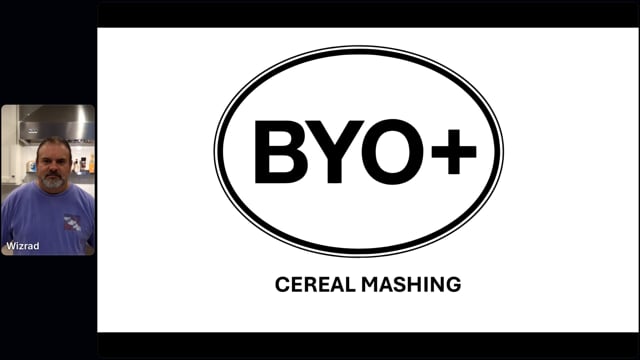Evaluating Malt
Video Transcript:
Welcome to the BYO+ video series. This episode will be tackling evaluating malt. We’re joined by BYO’s Technical Editor and Mr. Wizard columnist Ashton Lewis. Ashton.
Welcome to BYO+. Today’s presentation is going to be about malt evaluation for the practical brewer which will be a little bit different than other presentations that we’ve covered about analytical parameters of malt and hops and other other things. So this is a little bit more of a sensory experience, a little bit more hands-on. So I’ve got a couple tips here that I like to use when I’m thinking about a malt. So tip number one when it comes to looking at a new malt use is to read what’s written out there and keep in mind that malt is made by maltsters which I guess is kind of obvious. I work for a malting company and that’s what we do and usually the maltster has some ideas about what they think that they’re malt is gonna be good for in a beer. So there is good information out there by maltsters on how to apply a malt to different beers, but besides the information that comes from the supplier.
Look at other world of beer and see what other brewers are doing with these malts. A lot of a lot of brewers like to talk about the malts they use and you go into a tasting room and read about different beers and you’ll see that different malts are named and formulations and you can get a pretty good idea of different malts just by kind of paying attention of what’s out there and then the other thing that’s really cool is that if there are beers in the market that you know that contains certain malts that you’re interested in or if you’ve you know read about a certain malt you might want to kind of seek out what beers they’re in. You can do a market survey and and taste which is not only fun, but it’s very very educational. So that’s tip number one is to kind of do your your background research.
Tip number two is when we get into the kind of the Hands-On evaluation and this is kind of the old school method the so-called cut and chew method and what we’re going to do here is we’re gonna we’re gonna cut through a kernel which is also called a corn and we’re gonna look at the cross section of that cut. The cross section is going to tell us a little bit about how even the kernels are within a particular lot and the color is also going to be pretty informative. So I’m gonna refer to a device that you probably don’t have at home, but this is called a ferrinator and we’ll often thought that would make it great name for a doppelbock, Ferrinator Doppelbock, but a ferrinator you load up with grain kernels. And there’s a nice blade on the ferrinator and what the knife blade is going to do, it’s going to cut through the the sample of grain that’s in the ferrinator. So I’m going to go ahead and cut. And it kind of make some mess a little bit when it’s been cut but once the once the cut is made I’m going to open this up. And then go off camera here for a second while I open it and I’ll be back with what this reveals. And what we have is a nice display of the the kernels. That are that are cut through. And what what we use this for in practice kind of go back to the the main screen here. I can show you from my computer. What I’m going to do is look at the color. And this particular sample is fairly homogeneous. So I’ve got a fairly even color profile here. That’s one thing that we look at the other we might see little us what are called steely tips. So if we had little pieces of what it appears to be barley in here, which we don’t have those would be steely tips by the ferrinator now at home. You probably don’t have the ferrinator so you can do cuts with a razor blade or a knife if you’re interested in doing that.
Another way to cut grain is kind of a little bit more crude. If you literally bite it in half, in one kernel at a time, you can see the cross section of the the endosperm just simply by biting the grain with the your teeth. By chewing the grain you get some idea of how dry it is. If a grain is wet a lot of times you can tell by the texture that it’s picked up some moisture and you also get a nice flavor indication by by cutting and chewing. Now this is not something that’s really intuitive. It tells us something about the color. It tells us something about the grain that takes a lot of experience to really relate chewing malt to how beer taste because you know beer’s not grain, and wort is not beer.
So these worts are gonna transition when they’re used in the brewing process. But that is the method for using the hot steep to produce worts for sampling. So the conclusion of the physical evaluation of malts is that the malt should have a uniform and clean appearance. You know, when you’re looking at grain, you know, you don’t want to have malt that’s all broken up and it doesn’t, you don’t want to have malt that looks a lot different. So you’re looking for something that’s clean and uniform. So that’s one takeaway message.
Another takeaway here is that malt is the backbone of beer. It’s the soul of beer and if the malt doesn’t look good, if it doesn’t smell good, and it doesn’t taste good…well, the chance to make a really good beer with that are probably not great. So you do want to have malt that looks good, smells good, and tastes nice. So that’s kind of an obvious thing, but it’s worth repeating. The other great thing about what we’ve just done today is that no fancy tools are required. I did kind of break out a cool Show and Tell with the ferrinator, but you certainly don’t need a ferrinator to evaluate mall.
So the next time you’re ready to brew, give your malt a good evaluation. Don’t just assume that you’re going to pick up a bag of malt like a bag of flour into you know, dump it in the process go through the process evaluating. If you’re malt taste thought or doesn’t taste the way you expect it to then you probably don’t want to use it. You know, you don’t have to use grain just because you’ve purchased it because it takes a lot of time and energy to make beer at home. So hopefully that was useful and until next time, brew on!


